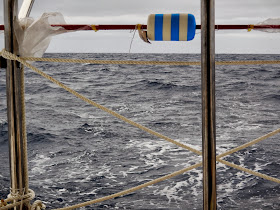I have been pondering the title of this post at length. Other options were An Elegy On A lost Age or even A Lament For Lost Culture. Both perhaps a bit on the heavy emotional side, so I opted for the more positive one.
We arrived at St Helena Island two days ago after sunset in a light drizzle. Not the easiest harbour entry after dark, with lots of small craft moored on mooring lines stretching across the harbour. We made it safely to one of the new mooring buoys, compliments of the skipper of another Leopard 39 yacht on delivery. He guided us on the VHF radio.
After a good night's sleep we hit the
sleepy Jamestown on a Sunday morning. Just to be stopped dead in our
tracks by HM Customs official. The very nice lady required the
skipper to go all the way back to the boat to get our passports. The
Harbour Master neglected to inform us that the Customs office was
open on a Sunday as well. We were under the impression that customs
clearance would keep to Monday morning.
The vagaries of the bureaucracy! At least we had some time to spend with the customs lady, who happened to be very helpful and informative on happenings and folklore on the island. We spent a happy half hour, entertained by her stories.

Then it was time to prep for our braai. I bought six sirloin steaks at our local Food Lover's Market, a food chain in South Africa. Vacuum packed and all. This we kept in the dark in our refrigerator on board, not frozen, for the duration of our passage. Needless to say, these steaks came out soft like butter.
We planned on having the braai at
Anne's Place, a rustic restaurant steeped in history, situated in the
castle gardens on St Helena. A wonderfully relaxed atmosphere to
share with friends. We arranged for some side dishes with Jane, the
lady of the house. And, of course, we invited friends. I had totally
misjudged the hospitality of the Saints and the next thing there were
provisions fit for a king, the table bending under the strain of the
amount of food. Luckily there were some more hungry sailors and we
could make a real dent the mound of food.
We spent a most enjoyable afternoon having a real traditional South African braai. I had the honour of cooking, as Richard, the man of the house, decreed that, since it was our braai and he being a guest, I would have to do the cooking. Or braaiing. Whatever. He was going to enjoy the ride.
Good conversation and good company. It was with heavy hearts that we took our leave of absence from our hosts to catch the last ferry of the day back to the boat.
Our sailor friends had postponed their hoisting anchor and casting off to after the braai. We waved a fond farewell to them as they disappeared into the dark, cloudy night. We may see them again in St Maarten, after crossing the Atlantic. They have another errand to attend to, so there is an odd chance that we shall only see them back in Cape Town in a month or so.
A wonderful experience. No cell phones, computers or other interruptions of electronic nature. The birds chirping away in the trees, with a light breeze making the leaves flutter every now and then.
Except that this very experience may be
made impossible by progress and modernisation.
The completion of the airport may put a
whole new angle on the niche that the island will fill in the tourist
industry. At present it looks like the people may opt for a
modernisation of the island.

Perhaps renovate the financial systems. Get better internet links. But keep the cell phones to a minimum. It is bliss to be away from electronic media for a while and to enjoy the company of friends. Especially in these rustic surroundings, where hardly a motor car is heard. And the peal of the church bells carried on the breeze. The sounds of peace.
But keep the rustic atmosphere.
There are but a few places on earth
left like this. And they are under threat of the very civilisation
that needs the peaceful and simple atmosphere.
Authored by Johan Zietsman
Last updated on 2013-10-07







































